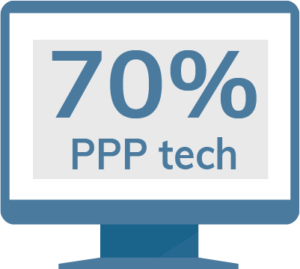Some commercial lenders might question why they should be talking about SBA lending now when they haven’t even processed PPP loan forgiveness applications for all of their customers or members yet. Or, they might wonder whether it’s too late to start 7(a) lending if they’ve never done it before the PPP. “It’s not too late to start, but it’s later than you think,” Wear said.
Lenders doing standard 7(a) SBA lending, considered the “mothership” of SBA loans, Wear said, will likely need a learning curve, and even lenders that have worked on 7(a) loans in the past may find that a lot has changed in recent years. SBA 7(a) loans have a maximum loan amount of $5 million, but multiple loans are allowed.
In addition, an institution cannot pass a known loss on to the government, so banks or credit unions considering refinancing existing debts on the books now will need to act quickly before financials demonstrate severe losses.
For existing loans to be eligible for SBA refinancing, they must be on what the SBA considers “unreasonable terms,” which can include the following:
- Having an interest rate over maximums for SBA program used
- Having a balloon payment, being a short-term note
- Having an aggressive pay down schedule or being over-collateralized
- Using debt to finance a change of ownership (where the new owner will own 100%).
In order to be eligible for SBA refinancing, the application must also meet a requirement that it will result in a 10% improvement (for term loans) in cash flow for debt service, which Wear said is generally fairly easy to meet, given the SBA’s longer terms.
SBA 7(a) guaranty amounts and fees are graduated based on the loan term and dollar amount, and the SBA does take a “haircut” on the lender rate for servicing, Wear said. Nevertheless, in his experience as an SBA lender, he never had an issue with internal pricing models or return on investment goals related to SBA lending.
However, as noted earlier, Wear said lenders might have a learning curve. SBA is very oriented to its Standard Operating Procedures, and it can be a very paperwork-heavy process. (By the way, the SBA recently announced updates to the SBA SOP for 7(a) programs that will be effective Oct. 1. The current SOP 50 10 5 (K) remains in effect until then.) SBA lending software that automates the application (SBA 1919), document-gathering, and submitting SBA loan applications to E-Tran, can help – as it did with the PPP.
Here are a few other tips Wear provided for SBA lending:
- Use your local SBA office and seek out private SBA experts (often former SBA lenders themselves).
- Have or develop a dedicated in-house SBA expert.
- Practice makes perfect.
- Communicate with the borrower up front about what information is needed and why.
Make use of in-house document monitoring to ensure proper SBA loan monitoring. “Not doing onsite checks until it’s too late or not updating financials are two popular reasons SBA reduces or even denies claims,” Wear said.
 Between the numbers of applicants, the strong demand for limited funds, and the restrictions on face-to-face transactions, financial institutions without automation were easily overwhelmed.
In fact, 70% of bank executives and directors said their institutions had implemented or upgraded an application or technology specific to PPP loans, according to Bank Director’s new 2020 Technology Survey.
Now, many of the nearly 5,500 SBA-approved lenders that are participating in the PPP are weighing the option of leveraging that technology to continue to provide SBA lending after PPP.
Between the numbers of applicants, the strong demand for limited funds, and the restrictions on face-to-face transactions, financial institutions without automation were easily overwhelmed.
In fact, 70% of bank executives and directors said their institutions had implemented or upgraded an application or technology specific to PPP loans, according to Bank Director’s new 2020 Technology Survey.
Now, many of the nearly 5,500 SBA-approved lenders that are participating in the PPP are weighing the option of leveraging that technology to continue to provide SBA lending after PPP. 






